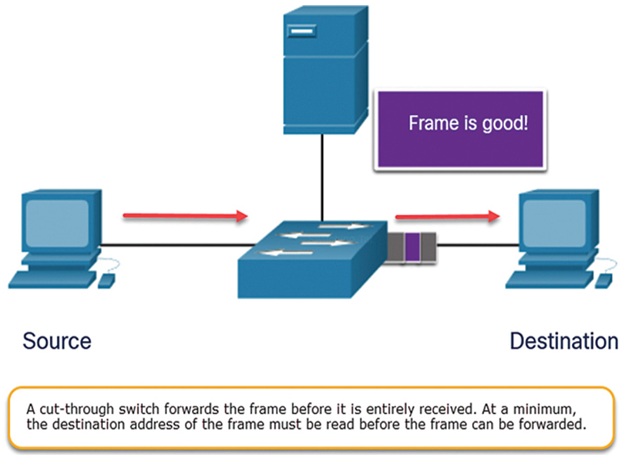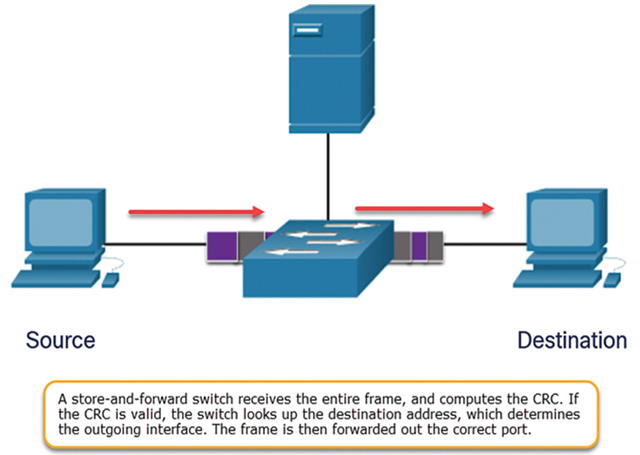Switch Speeds and Forwarding Methods (35.2)
Switches may have the capability to implement various forwarding methods to increase performance.
Frame Forwarding Methods on Cisco Switches (35.2.1)
As you learned previously, switches use their MAC address tables to determine which port to use to forward frames. With Cisco switches, there are actually two frame forwarding methods and there are good reasons to use one instead of the other, depending on the situation.
Switches use one of the following forwarding methods for switching data between network ports:
• Store-and-forward switching—This frame forwarding method receives the entire frame and computes the CRC. CRC uses a mathematical formula, based on the number of bits (1s) in the frame, to determine whether the received frame has an error. If the CRC is valid, the switch looks up the destination address, which determines the outgoing interface. Then the frame is forwarded out of the correct port.
• Cut-through switching—This frame forwarding method forwards the frame before it is entirely received. At a minimum, the destination address of the frame must be read before the frame can be forwarded.
A big advantage of store-and-forward switching is that it determines if a frame has errors before propagating the frame. When an error is detected in a frame, the switch discards the frame. Discarding frames with errors reduces the amount of bandwidth consumed by corrupt data. Store-and-forward switching is required for quality of service (QoS) analysis on converged networks where frame classification for traffic prioritization is necessary. For example, voice over IP (VoIP) data streams need to have priority over web-browsing traffic.
Figure 35-8 show the store-and-forward process.

Figure 35-8 Store-and-Forward Switching
Cut-Through Switching (35.2.2)
In cut-through switching, the switch acts upon the data as soon as it is received, even if the transmission is not complete. The switch buffers just enough of the frame to read the destination MAC address so that it can determine to which port it should forward out the data. The destination MAC address is located in the first 6 bytes of the frame following the preamble. The switch looks up the destination MAC address in its switching table, determines the outgoing interface port, and forwards the frame onto its destination through the designated switch port. The switch does not perform any error checking on the frame.
Figure 35-9 show the cut-through switching process.

Figure 35-9 Cut-Through Switching
There are two variants of cut-through switching:
• Fast-forward switching—Fast-forward switching offers the lowest level of latency. Fast-forward switching immediately forwards a packet after reading the destination address. Because fast-forward switching starts forwarding before the entire packet has been received, there may be times when packets are relayed with errors. This occurs infrequently, and the destination NIC discards the faulty packet upon receipt. In fast-forward mode, latency is measured from the first bit received to the first bit transmitted. Fast-forward switching is the typical cut-through method of switching.
• Fragment-free switching—In fragment-free switching, the switch stores the first 64 bytes of the frame before forwarding. Fragment-free switching can be viewed as a compromise between store-and-forward switching and fast-forward switching. The reason fragment-free switching stores only the first 64 bytes of the frame is that most network errors and collisions occur during the first 64 bytes. Fragment-free switching tries to enhance fast-forward switching by performing a small error check on the first 64 bytes of the frame to ensure that a collision has not occurred before forwarding the frame. Fragment-free switching is a compromise between the high latency and high integrity of store-and-forward switching, and the low latency and reduced integrity of fast-forward switching.
Some switches are configured to perform cut-through switching on a per-port basis until a user-defined error threshold is reached, and then they automatically change to store-and-forward. When the error rate falls below the threshold, the port automatically changes back to cut-through switching.
